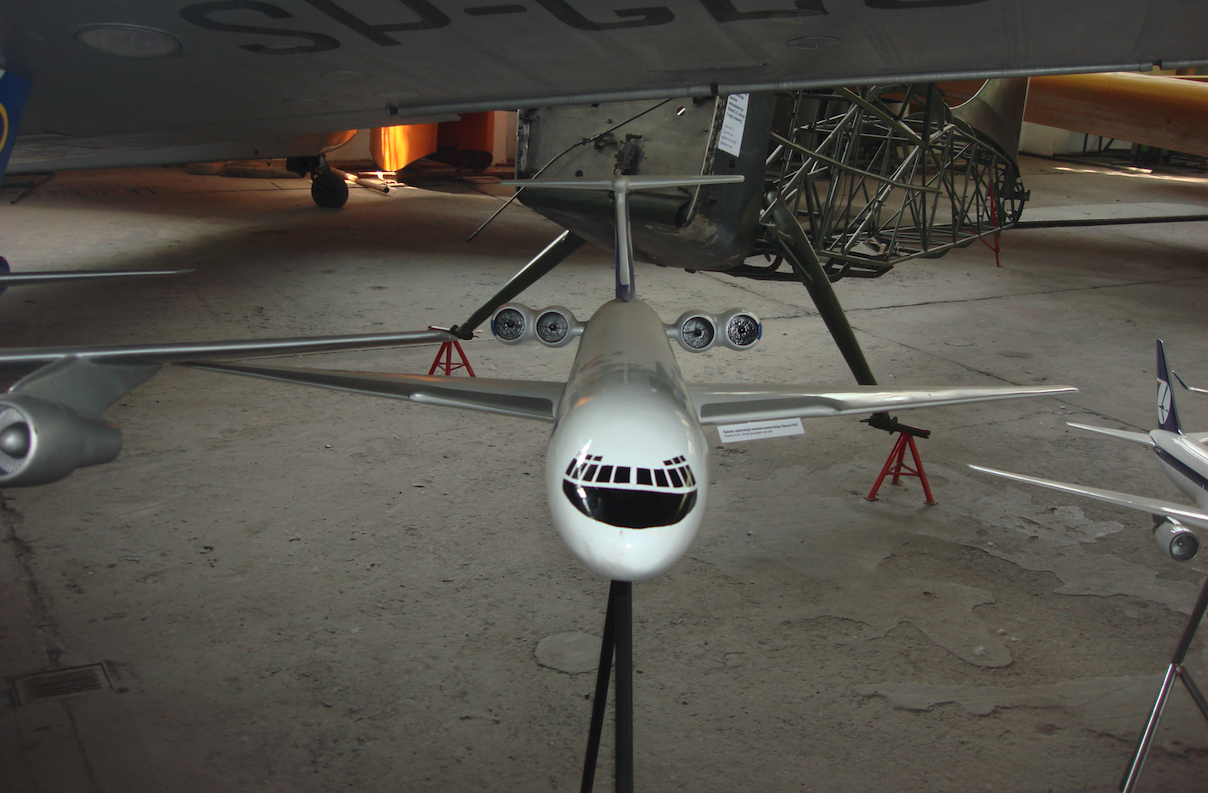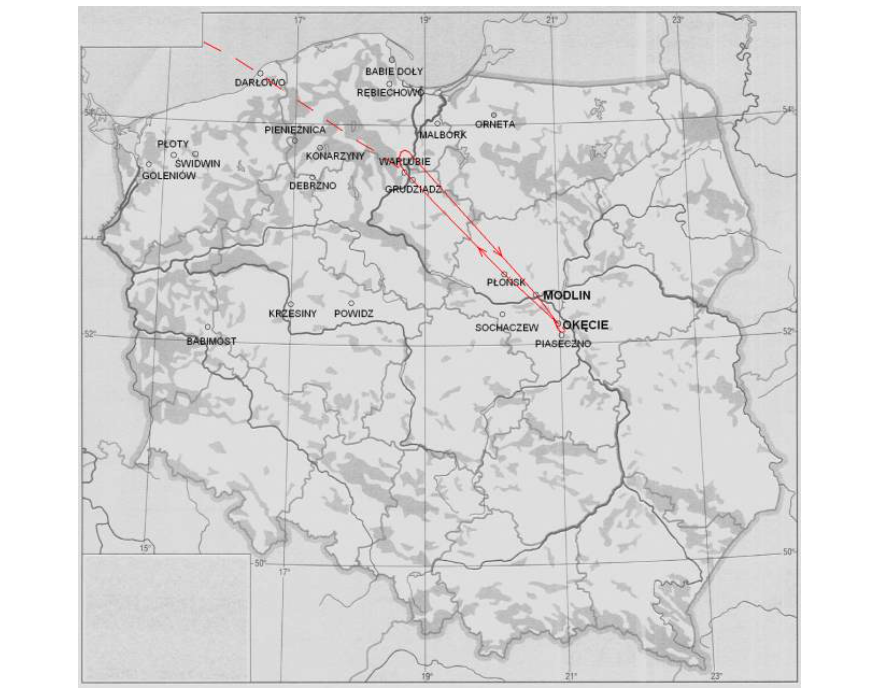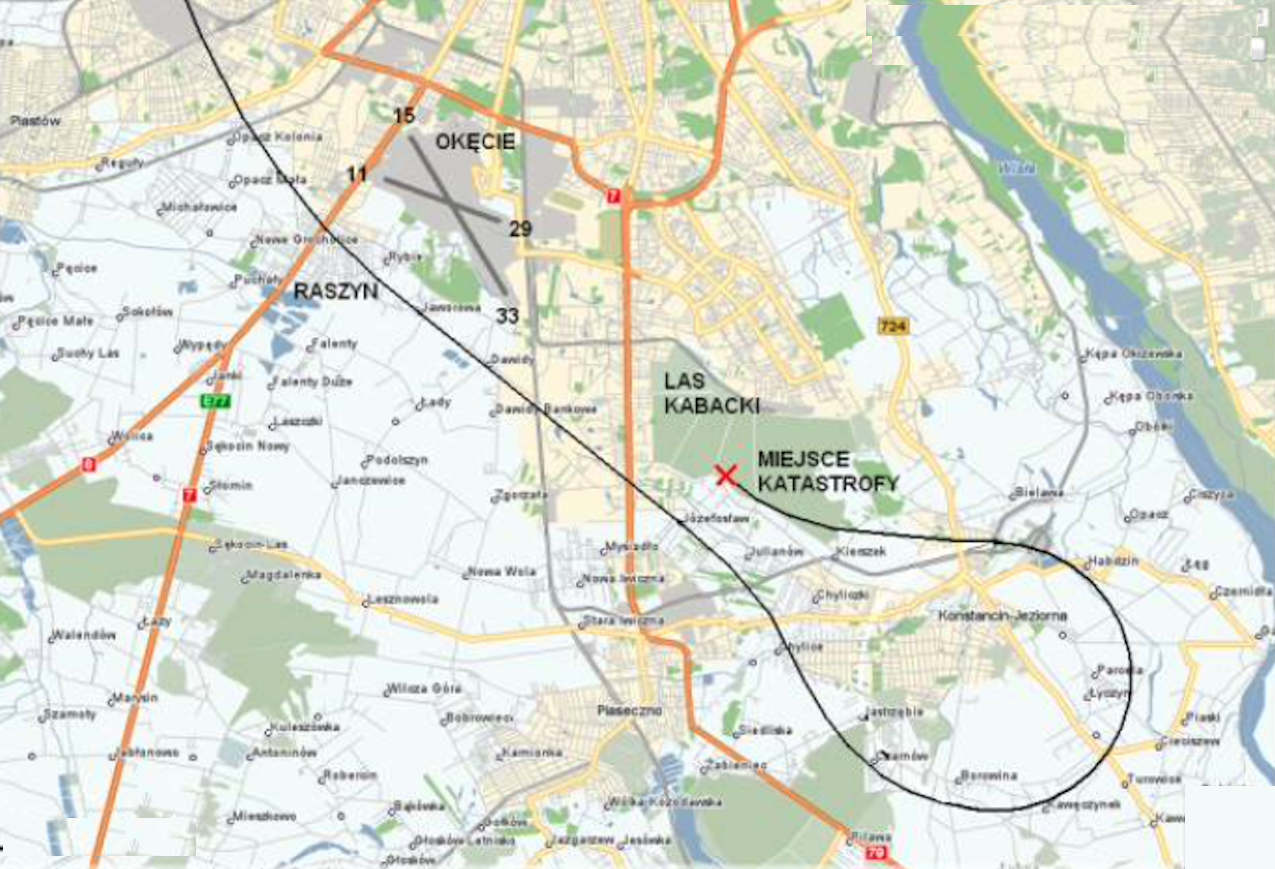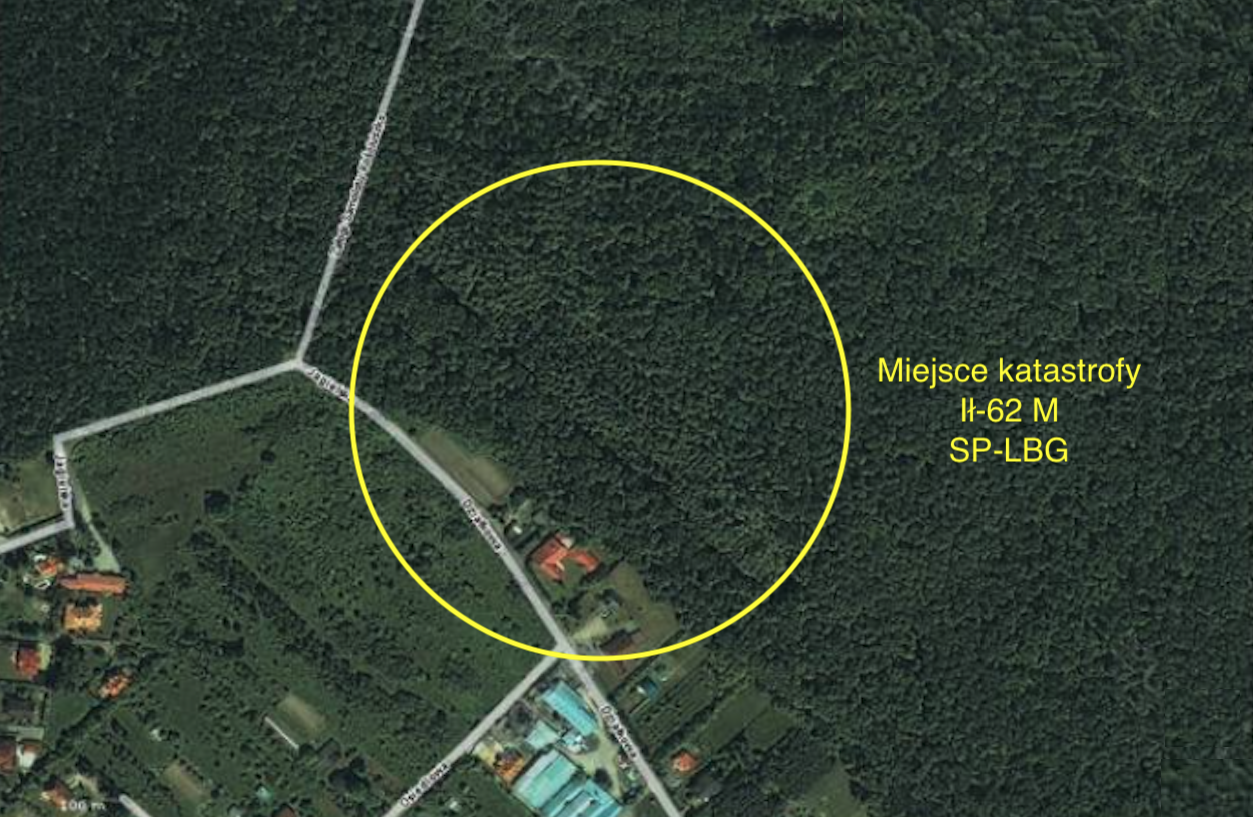Warszawa 2009-06-09
The crash of the IŁ-62 M SP-LBG Tadeusz Kościuszko plane.
Lot 5055.
The long-range turbojet Ił-62 M SP-LBG Tadeusz Kościuszko was purchased from the CCCP’s group of seven aircraft of this type and was delivered in 1984. The flight time until the crash was 6,971 hours. The aircraft made 1,752 landings. Planned service life of 30,000 hours, with major inspections every 10,000 hours.
On May 8, 1987, the plane crossed the Atlantic in its flight from Chicago to Warsaw. Passed a routine 6-hour inspection and preparation for the next flight over the Great Water.
On May 9, 1987, the crew headed by Captain Zygmunt Pawlaczyk – born on April 19, 1928, from 1951, military pilot, from 1955, pilot in PLL LOT, was preparing for the charter flight. Flight time 19,745 hours, including on the Il-62 aircraft – 5,542 hours, as the commander of the Il-62 / M aircraft – 3,725 hours. One of the most experienced pilots in LOT Polish Airlines. Leopold Karcher – co-pilot, born on 4 January 1933, from 1956, military pilot, from 1967, in LOT Polish Airlines. Flight time 10,899 hours, including on Il-62 / M airplanes – 2,357 hours. Lesław Łykowski – navigator, born on 2 January 1930, since 1975, in LOT Polish Airlines, Flight time 9,520 hours, including on Ił-62 / M planes – 3,156 hours. Leszek Bogdan – radio operator, born on April 11, 1944, since 1974, in LOT Polish Airlines. Flight time 9,520 hours, including on the Il-62 / M airplanes – 3,156 hours. Wojciech Kłossek – flight engineer, born on January 7, 1944, since 1975, in LOT Polish Airlines. From 1985, mechanic instructor on Il-18 planes, from 1986, mechanic on Il-62 M planes. Flight time 5,100 hours, including the Il-62 M plane – 291 hours. Ryszard Chmielewski – flight engineer instructor, born on September 28, 1933, since 1965, in LOT Polish Airlines. Flight time 10 571 hours, including on the Il-62 / M aircraft – 6 695 hours. Maria Berger-Senderska – flight attendant instructor, born on June 8, 1948, from 1974. at LOT. Flight time 6,300 hours. Hanna Chęcińska – senior flight attendant, born on September 19, 1951, from 1972. at LOT. Flight time 8,300 hours. Małgorzata Ostrowska – flight attendant, born on 3 January 1958, from 1980. at LOT. Flight attendant since 1986 Flight time 2 400 hours. Jolanta Potyra – flight attendant, born on May 28, 1946, from 1975. at LOT. Flight time 5,800 hours. Beata Płonka – junior flight attendant, born on August 18, 1963, from 1985. at LOT. Flight time 1 300 hours.
Passengers, 172 people, were taken on board, including five other LOT Polish Airlines employees; Mirosław Borowski – sales employee of the LOT representative office in New York, Maria Dytrych – ground flight attendant at the Warsaw-Okęcie airport, Dorota Jóźwik – specialist canvasser in the foreign tourism department of LOT-Air Tours, Jan Skibniewski – chief physician of the aviation and medical service, attending the congress to Las Vegas. Andrzej Wiechecki – senior salesman in the passenger acquisition department of LOT.
Two passengers who had problems with customs clearance were not allowed on board. Ms Janina Szulc, who has been living in New Jersey for several months, has not reported two expensive furs for clearance. Customs officers dug up on them. The formalities with writing out additional documents take a long time. The SP-LBG plane is not waiting. Mrs. Janina cursed the meticulous customs officers in her mind. An hour and a half later, she will bless them, throw herself on the necks of the downcast news of the catastrophe to the people in Okecie, shout: I am alive! On Monday, he will hand the meticulous customs officer a huge bouquet of flowers.
The charter flight planned for that day had the number LO 5055, and the route led from Okęcie to New York. The plane has been refueled. The take-off weight of the aircraft was 167,000 kg, including 73,000 kg of fuel. The weather conditions were favorable. The weather was sunny, the sky was clear and there was a light wind.
The SP-LBG take-off procedure started at 10:07 am. It was agreed that the start will take place from RWY in direction 33. The permission to start was issued at 10:17. The inrun was long because the machine was heavy. SP-LBG was in the air at 10:18.In accordance with the instructions from the Air Navigation Control station, the aircraft commander started to climb the plane to the cruising altitude of the R-23 airway towards Grudziądz. The departure of the Polish airspace was planned in the vicinity of Darłowo.
While leaving the Warsaw-Okęcie airport approach control airspace, the controller ordered to maintain the flight altitude at 4,876 m (16,000 ft) due to the fact that during the climb, when the plane passed the TMN beacon (Płońsk), the altitude 5 was not reached 486 m (18,000 ft). At an altitude of 5,181 m (17,000 ft), military aircraft were flying at the same time with which civilian control had no communication and would not be able to separate the aircraft at a safe distance when changing altitude.
Apart from TMN’s radio beacon, the air navigation of the SP-LBG aircraft was taken over by the Area Control Station and the aircraft continued to fly at an altitude of 4,876 m (16,000 ft). Until 10:41 the flight went smoothly.
At 10:31 a.m., the flight crew received an accelerated climb command from the Area Control Post to the cruising altitude of 9,448 m (31,000 ft). The on-board mechanic increased the speed of the engines, giving them full take-off power, with which the engines worked for the next 30 seconds.
During the flight over the town of Warlubie, at a speed of 815 km / h and at an altitude of 8,200 m, at 10:41 (in the 23rd minute of the flight), the flight crew noticed the loss of airtightness of the cabin (decompression), the loss of two engines and the fire of the plane.
Captain Zygmunt Pawlaczyk reported the emergency to the air navigation control station and decided to deviate from the planned flight route due to the danger, turn back and direct the plane to Warsaw. Due to the depressurization of the aircraft, the captain also decided to relatively quickly lower the flight altitude to 4,000 m. During the turning maneuver, a malfunction of the rudder was found. At 10:44 am, the aircraft’s signals indicated that the engine fire was extinguished and preparations for an emergency fuel discharge began.
The weight of Ił-62 M airplanes during landing should not exceed 107,000 kg, and 6,000 kg of fuel have been used since take-off. Landing an overloaded aircraft may expose it to serious damage, especially in an emergency landing aircraft. Dumping of fuel was permitted only in straight flight, and prohibited while circling in a restricted area. The idea is simply to prevent the plane from falling into its own deflated cloud, which could cause it to fire.
The troubles grew. The flight engineer stated that only one (out of the available four) electric current generators functioned properly. This situation resulted in insufficient power to supply electric current to the aircraft systems and in order to counteract it, the current receivers were turned off.
There were problems with an emergency fuel dump. The fuel discharge valves were electrically operated and did not work properly due to voltage decays in the operating network. The captain also found that the elevator was malfunctioning. He could only make adjustments to the elevator using the trimmer that is normally used for aerodynamic balance of the airplane.
The possibility of landing at the Gdańsk-Rębiechowo airport was considered for a while, but captain Zygmunt Pawlaczyk finally directed the plane to Warsaw.
The cause of the problems with the plane remained unknown to the crew. On board it was assumed that something must have hit the plane. One of the crew members described the situation with the words: The explosion was on the engine!
Due to the lack of engine power (two – No.1 and 2 were turned off, the plane flew only on two engines) and the heavy load of the plane (problems with an emergency fuel discharge), Captain Zygmunt Pawlaczyk could not maintain the flight altitude. There was a gradual lowering of the flight altitude. The crew assumed that something must have hit the elevator and due to the deteriorating situation, Captain Zygmunt Pawlaczyk asked for an emergency landing at the military airport in Modlin.
From the air traffic control station in Warsaw, the military air traffic control was contacted in order to arrange for permission to land the SP-LBG plane at the Modlin airport. At that time, the flight crew consulted the legitimacy of landing in Modlin, primarily taking into account the lack of knowledge about the technical conditions of the runway and weather conditions, which are of key importance for the landing of the plane, in particular the emergency landing plane.
Captain Zygmunt Pawlaczyk, due to the deterioration of the ability to effectively control the plane, urged the air traffic control station in Warsaw, reporting that the situation was becoming critical and it was necessary to make an emergency landing as soon as possible. At that time, the plane lowered its flight altitude to about 3,000 m. Sparks were also discovered from the rear of the plane.
The consent to land at the Modlin airport was issued at 10:54 am. The captain made a decision to start preparations for an emergency landing at the airport in Modlin and obtained information about the location, length of the runway and the direction of approach to it.
As it took a long time to obtain information about the weather conditions at the airport in Modlin, and above all about the direction of the wind – the conditions at the Warsaw-Okęcie airport were given – the crew held a meeting, reconsidering the possibility of landing at the airport in Warsaw. It was mainly taken into account that Warszawa-Okęcie has full protection in the event of a plane crash, which in this case was likely. The final decision at 11:00 was made by Captain Pawlaczyk, directing the plane to the Warsaw-Okęcie airport and resigning from landing in Modlin. The Warsaw-Okęcie airport had rescue services well prepared for the emergency landing of a large passenger plane and equipped with firefighting and rescue equipment. The Modlin airport was not so well equipped in this respect. Captain Zygmunt Pawlaczyk knew about it. At the time of the decision to continue the flight to Warsaw, the plane was approximately 90 kilometers from the Warsaw-Okęcie airport and was flying at a speed of 495 km / h at an altitude of 2,050 m.
Air traffic control directed the plane to Piaseczno. The captain called Maria Berger, a flight attendant instructor, to the cabin, ordered the passengers to be prepared for an emergency landing and to be seated during the operation.
At that time (11:04 am), there were still about 35 tons of fuel in the aircraft’s tanks, the dump valves were successfully opened and fuel was dumped again to the level of 32 tons, at which point the fuel discharge was interrupted again.
While approaching the airport due to a fire on board the plane, Captain Zygmunt Pawlaczyk demanded to lead the plane to runway 15/33 towards 15, the crew, however, had problems with accurately determining the location of the plane in relation to the runway. In this situation, Captain Pawlaczyk decided to approach the landing direction 33 from Piaseczno. The plane was coming from the north-west and had to go around the Okęcie airport over Raszyn from the west. This allowed for landing against the wind, with a higher touchdown speed, which was compensated for by the wind speed and along a steeper trajectory.
When the plane was near Józefosław, about 10,000 m from RWY, burnt-out elements of the construction and utility equipment fell off, igniting a fire in this area.
The disappearance of Hanna Chęcińska.
During the preparations on the plane for the emergency landing, the flight attendants discovered that one of them – Hanna Chęcińska, was missing on board the plane. The crew linked the lack of a flight attendant with a supposed tearing out of the door. In the press describing the crash, information appeared suggesting that Hanna Chęcińska was sucked outside the plane when the fuselage was depressurized and her remains were found. In fact, Hanna Chęcińska’s body has never been found, despite searches conducted by the ZOMO regiment (militarized militia units), in the forests around Warlubie. Hanna Chęcińska’s body was also not found at the crash site. Probably Hanna Chęcińska was in the technical room at the time of decompression, which was damaged by fragments of a torn turbine, and then – as a result of pressure drop and lack of oxygen, she lost consciousness and died in a fire in the rear part of the fuselage, and her body remained unrecognized among other 62 unidentified corpses.
The final phase of the SP-LBG’s emergency landing approach began at 11:08. On board, the landing gear not extended signal was activated. Air traffic control suggested that the plane should be led the shortest possible way, and Captain Pawlaczyk, having more and more problems with controlling the plane, made a tighter turn for this purpose. Failure to extend the landing gear meant the plane would have to land on its stomach. In addition, the crew reported a fire that was located in the trunk of the plane.
Air traffic control constantly gave the direction that Captain Zygmunt Pawlaczyk should take for a successful landing. In the last phase of the flight, the spread of fire on board the plane increased. The fire was visible to witnesses observing the plane from the ground. The fire damaged the trimmer control system, causing the plane to fly erratically – alternately descending and ascending. Less than 6,000 m before the airport, another swing of the plane could not be eliminated and the plane headed towards the ground, in Las Kabacki.
The course of the disaster.
One minute before the plane hit the ground, Captain Zygmunt Pawlaczyk announced: We are turning left. We will do whatever we can. At 11:12:13 the SP-LBG plane started cutting down the first trees of the Kabacki Forest at a speed of about 470 km / h. The last words recorded from the plane were: "Good night! Goodbye! Hello! We’re dying!"
As a result of the plane hitting trees and ground, its structure was completely disintegrated. The plane fragments were scattered over a distance of approximately 370 meters. The fuel remaining in the tanks caught fire and a fire broke out at the crash site. All persons on board the plane died on the spot as a result of the plane hitting trees and ground. The crash site is a rectangle 370 m long and 50 m wide.
Written by Karol Placha Hetman




